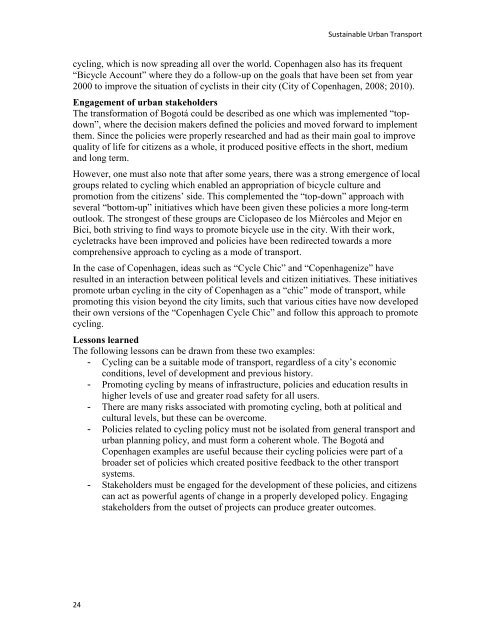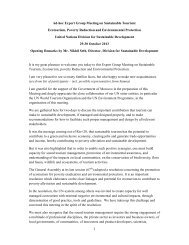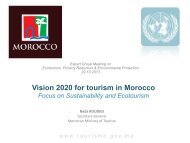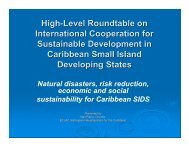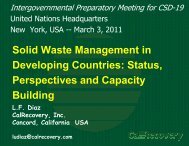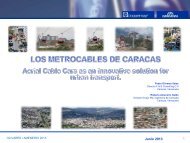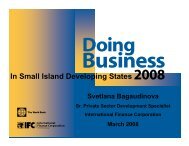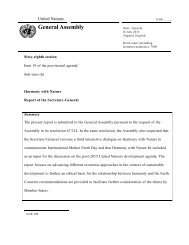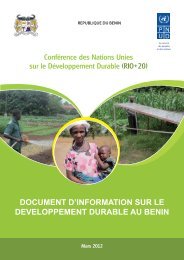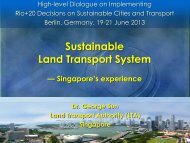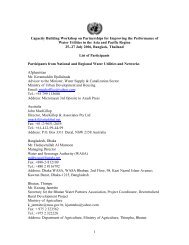A Guide for Sustainable Urban Development of the 21st Century
A Guide for Sustainable Urban Development of the 21st Century
A Guide for Sustainable Urban Development of the 21st Century
You also want an ePaper? Increase the reach of your titles
YUMPU automatically turns print PDFs into web optimized ePapers that Google loves.
<strong>Sustainable</strong> <strong>Urban</strong> Transportcycling, which is now spreading all over <strong>the</strong> world. Copenhagen also has its frequent“Bicycle Account” where <strong>the</strong>y do a follow-up on <strong>the</strong> goals that have been set from year2000 to improve <strong>the</strong> situation <strong>of</strong> cyclists in <strong>the</strong>ir city (City <strong>of</strong> Copenhagen, 2008; 2010).Engagement <strong>of</strong> urban stakeholdersThe trans<strong>for</strong>mation <strong>of</strong> Bogotá could be described as one which was implemented “topdown”,where <strong>the</strong> decision makers defined <strong>the</strong> policies and moved <strong>for</strong>ward to implement<strong>the</strong>m. Since <strong>the</strong> policies were properly researched and had as <strong>the</strong>ir main goal to improvequality <strong>of</strong> life <strong>for</strong> citizens as a whole, it produced positive effects in <strong>the</strong> short, mediumand long term.However, one must also note that after some years, <strong>the</strong>re was a strong emergence <strong>of</strong> localgroups related to cycling which enabled an appropriation <strong>of</strong> bicycle culture andpromotion from <strong>the</strong> citizens’ side. This complemented <strong>the</strong> “top-down” approach withseveral “bottom-up” initiatives which have been given <strong>the</strong>se policies a more long-termoutlook. The strongest <strong>of</strong> <strong>the</strong>se groups are Ciclopaseo de los Miércoles and Mejor enBici, both striving to find ways to promote bicycle use in <strong>the</strong> city. With <strong>the</strong>ir work,cycletracks have been improved and policies have been redirected towards a morecomprehensive approach to cycling as a mode <strong>of</strong> transport.In <strong>the</strong> case <strong>of</strong> Copenhagen, ideas such as “Cycle Chic” and “Copenhagenize” haveresulted in an interaction between political levels and citizen initiatives. These initiativespromote urban cycling in <strong>the</strong> city <strong>of</strong> Copenhagen as a “chic” mode <strong>of</strong> transport, whilepromoting this vision beyond <strong>the</strong> city limits, such that various cities have now developed<strong>the</strong>ir own versions <strong>of</strong> <strong>the</strong> “Copenhagen Cycle Chic” and follow this approach to promotecycling.Lessons learnedThe following lessons can be drawn from <strong>the</strong>se two examples:- Cycling can be a suitable mode <strong>of</strong> transport, regardless <strong>of</strong> a city’s economicconditions, level <strong>of</strong> development and previous history.- Promoting cycling by means <strong>of</strong> infrastructure, policies and education results inhigher levels <strong>of</strong> use and greater road safety <strong>for</strong> all users.- There are many risks associated with promoting cycling, both at political andcultural levels, but <strong>the</strong>se can be overcome.- Policies related to cycling policy must not be isolated from general transport andurban planning policy, and must <strong>for</strong>m a coherent whole. The Bogotá andCopenhagen examples are useful because <strong>the</strong>ir cycling policies were part <strong>of</strong> abroader set <strong>of</strong> policies which created positive feedback to <strong>the</strong> o<strong>the</strong>r transportsystems.- Stakeholders must be engaged <strong>for</strong> <strong>the</strong> development <strong>of</strong> <strong>the</strong>se policies, and citizenscan act as powerful agents <strong>of</strong> change in a properly developed policy. Engagingstakeholders from <strong>the</strong> outset <strong>of</strong> projects can produce greater outcomes.24


